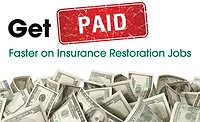Insider Secrets to Getting Claims Covered and You Paid Faster



If you have been in the restoration business for more than five years, you have likely noticed it is getting harder to collect from your customers who are dependent upon insurance proceeds and two-party checks to pay for your services. The drivers behind the increasing amount of red tape are changes in the insurance business and banking regulations, neither of which are likely to go away anytime soon. Therefore, it is a good idea to adapt your business model to deal with the realities that your clients are likely to face in getting you paid with insurance funds.
The IICRC recently hosted a webcast on how to deal with insurance claims and get paid faster. I was asked to present this this topic to IICRC-certified firms based on an article I wrote for R&R in February called “Get Paid Faster on Insurance Jobs.” The article was based on a $60,000 hail damage loss on my own home, which will take 12 months for me to have repaired.
After the February article in R&R, I learned even more about the arcane system the biggest home owner lender in the U.S. has set up to deal with paying for restoration work. If the insurance company issued a two-party check to pay for a loss over $5,000, you should assume your clients have been set up to waste a lot of time chatting with bankers in order to get you paid.
More recently, in July of this year, as a result of a backed up main line to the city sewer, water backed up into our office building from all of the drains on the first floor over a weekend. This provided me with first-hand experience with a Category 3 water loss on a commercial building and forced me to look into the insurance coverage interrelationships between tenants and owners for the first time.
The Double Hold-Back
Here is the essential problem in getting paid for insurance work: there is a double hold-back of funds between the insurance company and the bank, both of which will be happy to disburse all of the funds upon completion of the job. Both the bank and the insurance company want to confirm that the property has been repaired to its pre-loss condition by a licensed contractor before all the funds are released. The bank may require a signed contract that exactly matches the adjuster’s work sheet before the bank will even release the first progress payment.
Based on my experiences, restoration firms are well advised to assume the customer, commercial or residential, has no idea of the red tape they face to get you paid. Even with my unusual amount of knowledge and background about restoration work from being part of the industry for decades, I found the red tape for insurance payments in the banking business arcane and the insurance coverage gaps on commercial property policies between the property owner and tenants surprising. Anticipating the gauntlet your customer is going to run through to get insurance payments to you can cut out weeks of the funds release process at banks holding two-party check payments.
In my hail damage loss, I ended up spending four times as many hours explaining things to my lender as the total time I spent with the contractors to get the repairs done and with insurance company claims adjusters. Despite my background in insurance and restoration, there were still parts of my claim that were very hard to explain to a banker. For the average property owner, it is hard to imagine how anything ever gets paid to a restoration firm. It would have been a lot easier if I had appointed a single contractor as my representative to interface with the bank. I had two contractors, four adjusters, and the job will take over a year to complete.
Over time, the complexity of my claim put the automated systems in place to monitor jobs like this out of commission. If one of the restorers would have told me it was in important to have a single contract and that the restorer would handle the bank two-party check interface, I would have taken that option.
Insurance Company Process
Getting a check from the insurance company is easier than the process with the bank. The insurance company only wants to pay for the depreciated value of the damaged property, unless the property is actually repaired. Before the insurance company pays the difference between the depreciated value and the actual cost to put on a new roof for example, the insurance company needs to confirm the work has been completed. This process is usually simple. The homeowner needs a certificate of project completion and the invoice that matches the contract to perform the work, which also matches the adjuster’s scope.
Bank Process
The banker wants to protect their security interest in the property. The lender’s security interest in a property is the difference between the value of the home and the outstanding loan. After the banking problems around 2008, banking regulators started to pressure banks to tighten up their lending practices. One of those areas of regulatory scrutiny was the loan-to-value ratio in a bank’s portfolio of loans. Restoration contractors are now caught up in that regulatory web designed to prevent another banking collapse.
Today, lenders have to make sure a damaged property is fixed to its pre-loss condition or their loan-to-value ratios are adversely impacted. What does that mean for the restorer? It means the lender is now very interested in the work you do on a property they have a loan out on. The lender will want to confirm the damages are repaired by a competent contractor and there are no liens left on the property once the contractor is paid for the work completed.
When I went to my bank to cash a two-party insurance check so I could start paying my contractors, the bank would not cash the check until I had complied with 15 pages of hard-to-understand red tape requirements. I also had to provide the following:
- An actual copy of the contractor’s license (the number may not be enough). I suggest providing a copy of the license with your estimate and contract, even if you don’t need a license for the work you’re performing.
- A contract signed by me (the property owner) and the contractor that detailed the scope of work to be provided.
- The contracted scope of work, which needs to be an exact match to the claims adjuster’s work estimate if possible. If there is a mismatch between these two documents, it can take property owner many weeks to get the bank to understand why that is. It is easier to get the documents to match.
The lender’s restoration auditing process can also delay the release of funds by many months. My bank has implemented a protocol which links the release of funds from the homeowner’s restoration and repair escrow bank account to job completion milestones, which need to be confirmed by inspectors working for the bank.
For a project where the work takes place over a longer period of time, there may be multiple inspections of the property by the lender. I found out the hard way if the mid-point bank inspection is not done, at some point no further funds will be released, which is a problem when there are two contractors on different time frames working on the same property. No one at the bank told me about that mandatory inspection process and it took weeks to unravel what the hang up was on a progress payment.
Upon project completion, before the banks would release my insurance proceeds from the mandatory property repair escrow account they set up for me, the banker needed:
- A Certification of Completion supplied by the contractor. The completed work should match the descriptions in the claims adjuster estimate.
- A Conditional Waiver of Lien, on the lender’s form.
- A W-9 IRS form taken directly from the IRS website. Another outcome of bank regulation reform is the IRS wants to track contractor’s income where it can, and bank payments for restoration work is one way to do that. In my case, the IRS would not accept the W-9 form I found in my bank’s 15-page instructions on what I would need to do to get my money out of their bank to pay my contractors. Redoing my bank’s supplied W-9 IRS form added two weeks of payment delay after I had to spend an hour on the phone trying to figure out why the bank’s computer was telling me by e-mail that my request for funds was deficient. Which brings me to another warning: if the property owner is not internet savvy with scanning and fax capability, I have no idea how funds are ever released from a bank. Which is another reason to volunteer to be the property owner’s representative with the lender for escrow funds disbursement. In my case when I initially logged in to create the restoration escrow account, I had the option to authorize a contractor to be my representative to the bank. Had I have done, so I could have accelerated the funds release by four months.
- The bank’s final inspection of the property to confirm the work was done to their satisfaction.
Restorers who counsel the property owner on this process and work proactively to set the job up to flow though the bank’s required process should be able to significantly reduce the time delays in getting paid under two-party checks.
Commercial Property Checks
Getting paid on commercial property restoration projects may involve all of the above steps for a two-party check if the job is being performed for the property owner and there is a loan out on the property.
But be warned. If Category 3 water is involved, there is very likely not enough insurance money to pay for the work. A simple search on R&R’s website will turn up multiple articles by me on this very topic.
In my office building, under a triple net lease, the tenants are responsible for their own insurance coverage and the property owner is responsible for the common areas. No one has enough insurance to deal with a Cat 3 water loss.
One tenant was out of insurance coverage in the first six hours of the loss; they will be shut down for three weeks and the clock is ticking on the business interruption side of the insurance coverage at $15,000 per day. They also have to pay for a dry out and rebuild of the floors and lower drywall.
Another tenant does not think they have the funds, through insurance or otherwise, to repair the floor and walls and reopen their business, a reality the business owner recognized within a few hours of arriving on a Monday morning to sewage covering floors throughout their entire suite.
Almost all commercial property owners and their tenants are severely underinsured for mold and bacteria-related losses today. The same insurance agents that leave restorers with insurance coverage gaps for pollution/fungus/mold/bacteria/Category 3 water on the liability insurance policies leave property owners uninsured for the same things. The vast majority of insurance agents and adjusters receive no training on these coverage topics, which has been a good thing for property owners in the past. That situation is changing fast.
Getting paid faster or being paid at all requires knowledge of changes in the insurance and banking business. Where there is collectable insurance coverage, anticipating the bank’s requirements to have funds released from a restoration escrow can cut months off the payment cycle. On commercial properties, evaluating the customer’s ability to pay you for the work you are about to perform is much more important than ever before.
A twist to that topic is getting paid at all for Cat 3 water losses on commercial property policies. I provided some advice on how to avoid that situation in the IICRC webcast, which you can watch here: https://youtu.be/OZ3y3tdp3bI. I will also follow up with an article in R&R as the situation with the Cat 3 water loss in our office building develops.
Looking for a reprint of this article?
From high-res PDFs to custom plaques, order your copy today!








